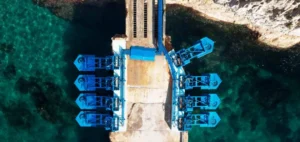CalWave completes open ocean pilot project. Thus, the Californian company demonstrates the potential of wave energy.
X Wave, the promising technology of CalWave
This success of CalWave’s pilot project marks the end of a ten-month test on the West Coast of the United States. Conducted in partnership with the DOE, this study was to measure the effectiveness of the X Wave technology in the open ocean.
This is the first project of this magnitude to demonstrate the potential of this technology on a large scale. According to Jennifer Garson of DOE, this is a critical step in the commercialization of this energy source.
She states:
“Technologies like X Wave hold incredible potential to transform our energy production system. They can help coastal populations reduce their dependence on fossil fuels by leveraging the exploration of this marine energy source.”
A powerful and safe technology
During the test period, the CalWave system achieved the performance of hydrodynamic simulations validated in the laboratory. The on-board control system worked autonomously about 80% of the time of the operation.
The device ensured high performance with 99% network availability during the deployment period. The system has also demonstrated its robustness by withstanding high intensity storms and corrosion.
CalWave applied an environmentally friendly bio-coating to the X1’s hull to mimic erosion.
Given the effectiveness of the autonomous technology during the test phase, the operation was extended from 6 to 10 months.
A project that respects the marine environment
The CalWave team was able to monitor the impact on the marine environment using the sensors built into their system. The company has also partnered with the Pacific Northwest National Laboratory (PNNL) to operate audio and visual monitoring tools.
The company relied on the expertise of key partners for environmental preservation. These include the National Renewable Energy Laboratory, Sandia Laboratories, MarineLabs and UC Berkeley.






















